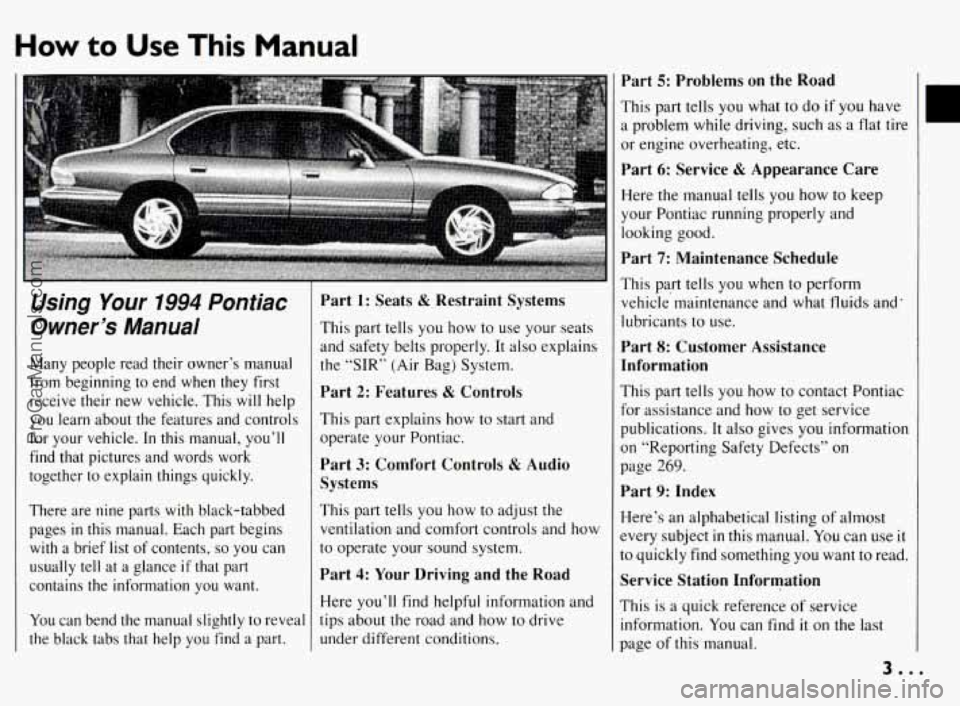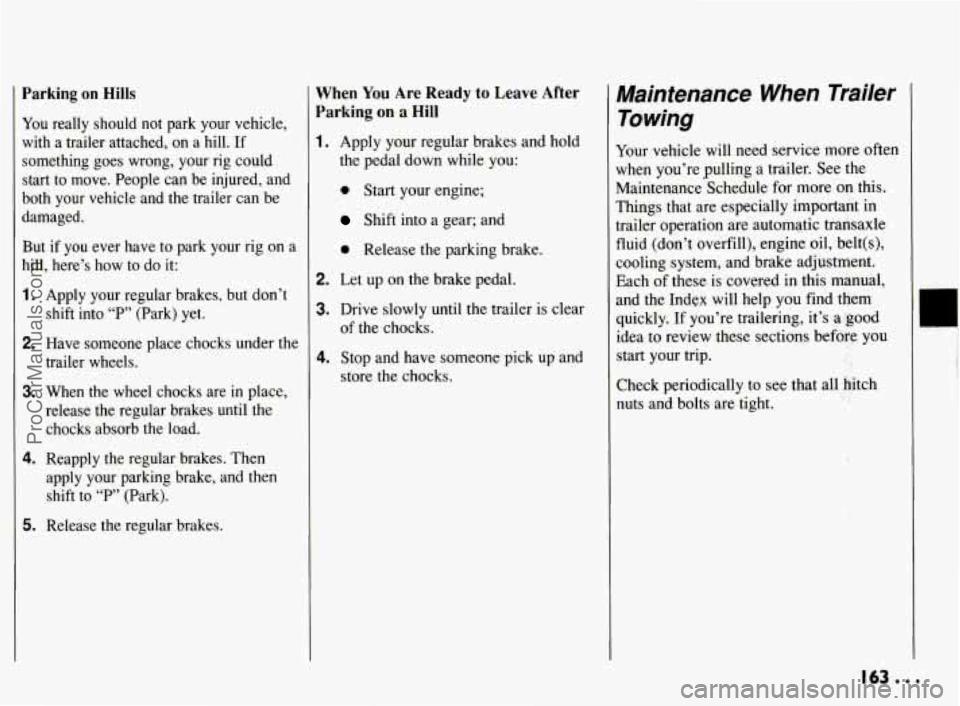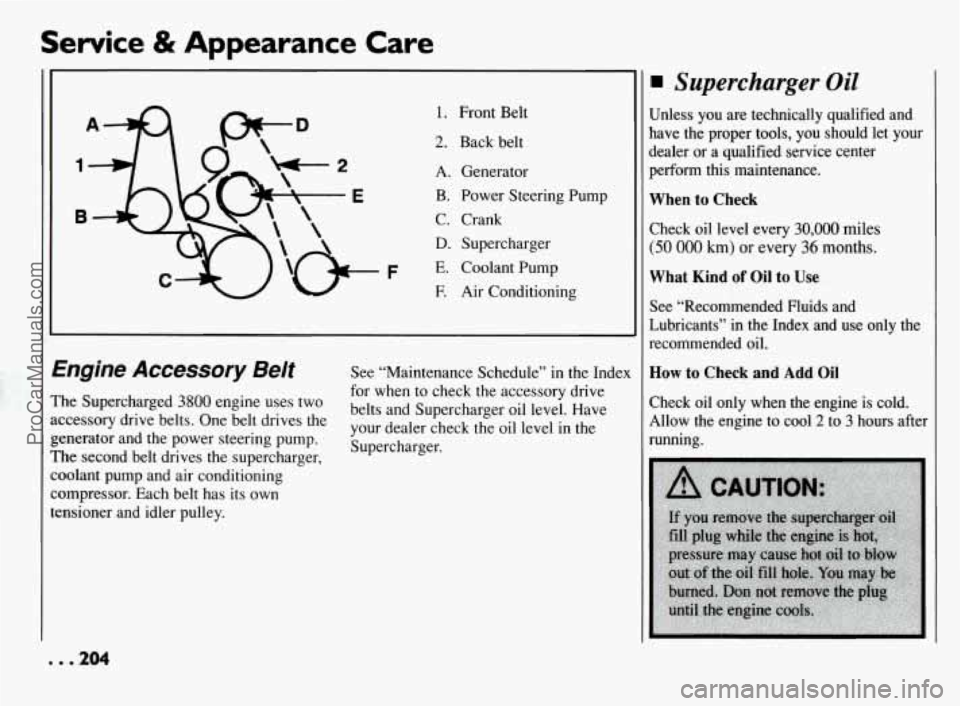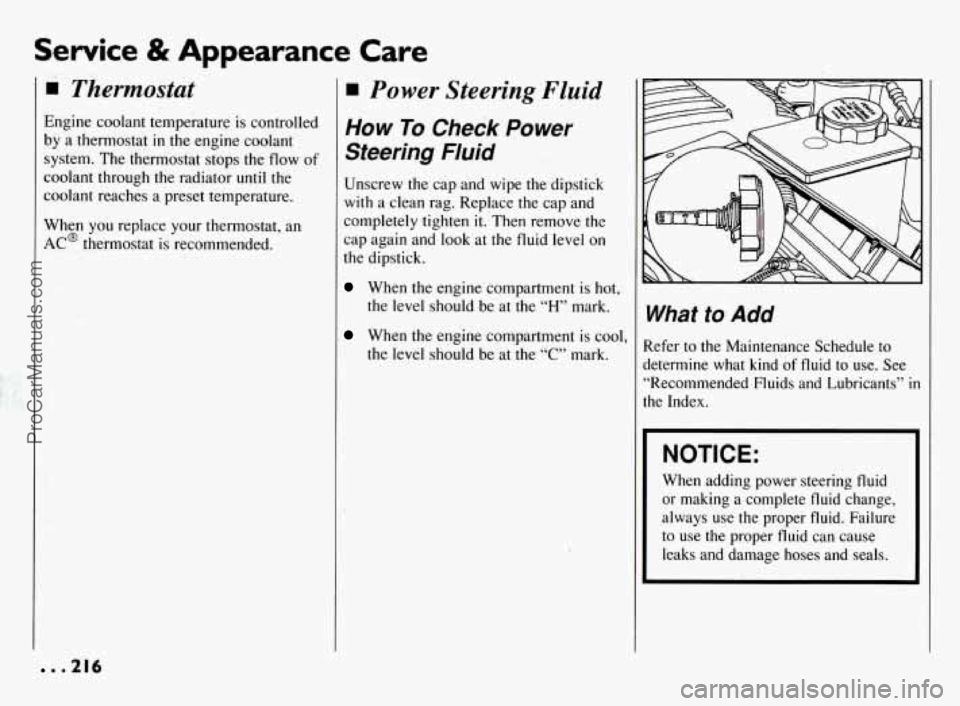Page 2 of 290
p Pontiac Bonneville
1994 Owner’s Manual
Table of Contents
Introduction HOW to Use This Manual ............
Part I Seats & Restraint Systems ........... 7L
Part 2 Features & Controls ............... 41 c
Part 3 Comfort Controls & Audio Systems . I I I I
Part 4 Your Driving and the Road ......... 137 E
Part 6 Service & Appearance Care ........ 193 I
Part 5 Problems on the Road ............. 165
Part 7 Maintenance Schedule ............ 247 E
Part 8 Customer Assistance Information . . 265
Part9 Index ........................... 279 I
Includes “Reporting Safety Defects” on page 269.
Service Station Information . . Last Page
Printed in USA 10260958 A Second Edition ...
ProCarManuals.com
Page 4 of 290

How to Use This Manual
Using Your 1994 Pontiac
Owner’s Manual
Many people read their owner’s manual
from beginning
to end when they first
receive their
new vehicle. This will help
you learn about the features and controls
for your vehicle. In this manual, you’ll
find that pictures and words work
together
to explain things quickly.
There are nine parts with black-tabbed pages
in this manual. Each part begins
with a brief list of contents,
so you can
usually tell at a glance
if that part
contains the information you want.
You can bend the manual slightly to reveal
the black tabs that help you find a part.
This part tells you how to use your seats
and safety belts properly. It also explains
the “SIR’ (Air Bag) System.
Part 2: Features & Controls
This part explains how to start and
operate your Pontiac.
Part 3: Comfort Controls & Audio
Systems
This part tells you how to adjust the
ventilation and comfort controls and how
to operate your sound system.
Part 4: Your Driving and the Road
Here you’ll find helpful information and
tips about the road and how
to drive
under different conditions.
Part 5: Problems on the Road
This part tells you what to do if you have
a problem while driving, such as a flat tire
or engine overheating, etc.
Part 6: Service & Appearance Care
Here the manual tells you how to keep
your Pontiac running properly and
looking good.
Part 7: Maintenance Schedule
This part tells you when to perform
vehicle’maintenance and what fluids and’
lubricants to use.
Part 8: Customer Assistance
Information
This part tells you how to contact Pontiac
for assistance and how
to get service
publications. It also gives
you information
on “Reporting Safety Defects”
on
page 269.
Part 9: Index
Here’s an alphabetical listing of almost
every subject
in this manual. You can use it
to quickly find something you want to read.
Service Station Information
This is a quick reference of service
information.
You can find it on the last
page of this manual.
3..
ProCarManuals.com
Page 164 of 290

Parking on Hills
You really should not park your vehicle,
with a trailer attached, on a hill.
If
something goes wrong, your rig could
start to move. People can be injured, and
both your vehicle and the trailer can be
damaged.
But if you ever have to park your rig on a
hill, here’s how to do it:
1.
2.
3.
4.
5.
Apply your regular brakes, but don’t
shift into
“P” (Park) yet.
Have someone place chocks under the
trailer wheels.
When the wheel chocks are in place,
release the regular brakes until the chocks absorb the load.
Reapply the regular brakes. Then
apply your parking brake, and then shift to
“F”’ (Park).
Release the regular brakes.
When You Are Ready to Leave After
Parking
on a Hill
1.
2.
3.
4.
Apply your regular brakes and hold
the pedal down while you:
0 Start your engine;
Shift into a gear; and
0 Release the parking brake.
Let up on the brake pedal.
Drive slowly until the trailer is clear
of the chocks.
Stop and have someone pick up and
store the chocks.
Maintenance When Trailer Towing
Your vehicle will need service more often
when you’re pulling a trailer.
See the
Maintenance Schedule for more
on this.
Things that are especially important in
trailer operation are automatic transaxle
fluid (don’t overfill), engine oil, belt(s),
cooling system, and brake adjustment,
Each
of these is covered in this manual,
and the Index will help you find them
quickly. If you’re trailering, it’s a good
idea to review these sections before. you
start your trip.
Check periodically to
see that all hitch
nuts and bolts are tight.
,j.;
i .a
1. i
,
.?.
163...
ProCarManuals.com
Page 205 of 290

Service & Appearance Care
F
1.
2.
A.
B.
C.
D.
E.
E
Front Belt
Back belt
Generator
Power Steering Pump
Crank Supercharger
Coolant Pump
Air Conditioning
tngine Accessory Belt
‘he Supercharged 3800 engine uses two
ccessory drive belts. One belt drives the
enerator and the power steering pump.
‘he second belt drives the supercharger,
oolant pump and air conditioning
ompressor. Each belt has its own
msioner and idler pulley.
. . 204
See “Maintenance Schedule” in the Index
for when to check the accessory drive
belts and Supercharger oil level. Have
your dealer check the oil level in the
Supercharger.
Supercharger Oil
Unless you are technically qualified and
have the proper tools, you should let your
dealer or a qualified service center
perform this maintenance.
When to Check
Check oil level every 30,000 miles
(50 000 km) or every 36 months.
What Kind of Oil to Use
See “Recommended Fluids and
Lubricants” in the Index and use only the
recommended oil.
How to Check and Add Oil
Check oil only when the engine is cold.
Allow the engine to cool
2 to 3 hours after
running.
ProCarManuals.com
Page 210 of 290
Used oil can be a real threat to the
environment. If you change your own oil,
be sure to drain all free-flowing oil from
the filter before disposal. Don’t ever
dispose of oil by putting
it in the trash,
pouring it on the ground, into sewers, or
into streams or bodies of water. Instead,
recycle
it by taking it to a place that
collects used oil.
If you have a proplem
properly disposing of your used oil; ask
your dealer, a service station or a local
recycling center for help.
Air Cleaner
Refer to the Maintenance Schedule to
determine when to replace the air filter.
See “Scheduled Maintenance Services” in
the Index.
NOTICE:
If the air cleaner is off, a backfire
can cause a damaging engine fire.
And, dirt can easily get into your
engine, which will damage it.
Always have the air cleaner in place
when you’re driving.
To Check or Replace (3800 Engine):
1. Unscrew the three wing screws in the
housing cover and pull back.
t
209.. .
ProCarManuals.com
Page 212 of 290
2. Unscrew the clamp on the air intake
hose where the hose attaches to the
throttle body near the top
of the
engine. Detach the hose from the
throttle body, then pull back the rear
of the housing cover.
3. Remove the air filter,
4. Be sure to install the air filter and
replace the cover tightly.
5. Reattach the air intake hose and
tighten the clamp.
Automatic Transaxle
Fluid
When to Check and
Change
A good time to check your automatic
transaxle fluid level is when the engine oil
is changed..Refer to the Maintenance
Schedule to determine when to. change
your fluid. See “Scheduled Maintenance
Services”
in the Index.
How to Check
,- , .. : : j! ? !i
Because this operation can be a little
difficult,
you may choose to have this
done at a Pontiac Dealership Service
Department.
211 b..
ProCarManuals.com
Page 217 of 290

Service & Appearance Care
Thermostat
Engine coolant temperature is controlled
by a thermostat
in the engine coolant
system. The thermostat stops the flow
of
coolant through the radiator until the
coolant reaches a preset temperature.
When you replace your thermostat, an
AC@ thermostat is recommended.
Power Steering Fluid
How To Check Power
Steering
Fluid
Unscrew the cap and wipe the dipstick
with a clean rag. Replace the cap and
completely tighten
it. Then remove the
cap again and look at the fluid level on
the dipstick.
When the engine compartment is hot,
the level should be at the
“H” mark.
When the engine compartment is cool,
the level should be at the “C” mark.
What to Add
Refer to the Maintenance Schedule to
determine what kind
of fluid to use. See
“Recommended Fluids and Lubricants”
in
the Index.
NOTICE:
When adding power steering fluid
or making a complete fluid change,
always
use the proper fluid. Failure
to use the proper fluid can cause
leaks and damage hoses and seals.
. .216
ProCarManuals.com
Page 226 of 290
When to Check
Check your tires once a month or more.
Don’t forget your compact spare tire. It
should be at
60 psi (420 kPa).
How to Check
Use a good quality pocket-type gage to
check tire pressure. Simply looking at the
tires will.not tell you the pressure,
especially
if you have radial tires --
which may look properly inflated even if
they’re underinflated.
If your tires have valve caps, be sure to
put them back on. They help prevent
leaks by keeping out dirt and moisture.
Tire lnspecfion and
Rotafion
To make your tires last longer, have them
inspected and rotated at the mileages
recommended
in the Maintenance
Schedule. See “Scheduled Maintenance Services” in the Index.
X5028
Use this rotation pattern.
After the tires have been rotated, adjust
the front and rear inflation pressure as
shown on the Tire-Loading Information
label. Make certain that all wheel nuts are
properly tightened. See “Wheel Nut
Torque” in the Index.
e
225 . .
ProCarManuals.com